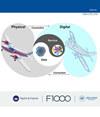Application of image recognition technology in digital twinning technology: Taking tangram splicing as an example
引用次数: 0
Abstract
Background: With the rapid development of digital twinning technology, the compatibility of digital twinning technology to other technologies is continuously enhanced. It is because of this that the application of image recognition technology in digital twinning technology becomes a reality. However, the key technology of digital twin, the virtual-actual mutual control technology, is not mature enough, and the image recognition technology applied in digital twin technology also has the problem of coordinate system transformation, which becomes an important link of image recognition technology in digital twin. Methods: Based on the above two problems, we take the tangram splicing project as an example to realize a virtual-actual mutual control method, so that the digital twinning technology can be well presented. Furthermore, we implement an image recognition applied to the conversion of digital twinning technology, so that digital twinning technology and image recognition have a seamless connection, allowing the application range of digital twinning technology to be further expanded. Results: In this paper, image recognition technology is successfully applied to digital twin technology by adopting the conversion between different coordinate systems and the real and virtual real time control, which makes the applicability of digital twin technology in high-tech fields such as smart factories and smart manufacturing to a higher level. Conclusions: Finally, through the tangram splicing project, the motion trajectories of the robotic arm and the tangram are consistent with the virtual robotic arm and the tangram in the computer. It is proved that our method can well combine digital twinning technology and image recognition technology.图像识别技术在数字结对技术中的应用——以七巧板拼接为例
背景:随着数字孪生技术的快速发展,数字孪生技术与其他技术的兼容性不断增强。正因为如此,图像识别技术在数字孪生技术中的应用才成为现实。然而,数字孪生的关键技术虚实互控技术还不够成熟,而应用于数字孪生技术的图像识别技术还存在坐标系变换的问题,这成为数字孪生中图像识别技术的重要环节。方法:针对以上两个问题,以七巧板拼接项目为例,实现一种虚实互控的方法,使数字孪生技术得到很好的体现。此外,我们实现了一种应用于数字孪生技术转换的图像识别,使数字孪生技术与图像识别无缝连接,进一步扩大了数字孪生技术的应用范围。结果:本文通过采用不同坐标系之间的转换和实、虚实时控制,将图像识别技术成功应用于数字孪生技术,使数字孪生技术在智能工厂、智能制造等高科技领域的适用性提高到一个新的水平。结论:最后,通过七巧板拼接项目,机器人手臂和七巧板的运动轨迹与虚拟机器人手臂和计算机中的七巧板一致。实验证明,该方法可以很好地将数字孪生技术与图像识别技术相结合。
本文章由计算机程序翻译,如有差异,请以英文原文为准。
求助全文
约1分钟内获得全文
求助全文
来源期刊

Digital Twin
digital twin technologies-
自引率
0.00%
发文量
0
期刊介绍:
Digital Twin is a rapid multidisciplinary open access publishing platform for state-of-the-art, basic, scientific and applied research on digital twin technologies. Digital Twin covers all areas related digital twin technologies, including broad fields such as smart manufacturing, civil and industrial engineering, healthcare, agriculture, and many others. The platform is open to submissions from researchers, practitioners and experts, and all articles will benefit from open peer review.
The aim of Digital Twin is to advance the state-of-the-art in digital twin research and encourage innovation by highlighting efficient, robust and sustainable multidisciplinary applications across a variety of fields. Challenges can be addressed using theoretical, methodological, and technological approaches.
The scope of Digital Twin includes, but is not limited to, the following areas:
● Digital twin concepts, architecture, and frameworks
● Digital twin theory and method
● Digital twin key technologies and tools
● Digital twin applications and case studies
● Digital twin implementation
● Digital twin services
● Digital twin security
● Digital twin standards
Digital twin also focuses on applications within and across broad sectors including:
● Smart manufacturing
● Aviation and aerospace
● Smart cities and construction
● Healthcare and medicine
● Robotics
● Shipping, vehicles and railways
● Industrial engineering and engineering management
● Agriculture
● Mining
● Power, energy and environment
Digital Twin features a range of article types including research articles, case studies, method articles, study protocols, software tools, systematic reviews, data notes, brief reports, and opinion articles.
 求助内容:
求助内容: 应助结果提醒方式:
应助结果提醒方式:


